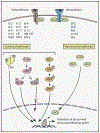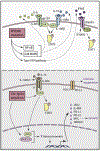Janus kinase deregulation in leukemia and lymphoma
- PMID: 22520846
- PMCID: PMC7480953
- DOI: 10.1016/j.immuni.2012.03.017
Janus kinase deregulation in leukemia and lymphoma
Abstract
Genetic alterations affecting members of the Janus kinase (JAK) family have been discovered in a wide array of cancers and are particularly prominent in hematological malignancies. In this review, we focus on the role of such lesions in both myeloid and lymphoid tumors. Oncogenic JAK molecules can activate a myriad of canonical downstream signaling pathways as well as directly interact with chromatin in noncanonical processes, the interplay of which results in a plethora of diverse biological consequences. Deciphering these complexities is shedding unexpected light on fundamental cellular mechanisms and will also be important for improved diagnosis, identification of new therapeutic targets, and the development of stratified approaches to therapy.
Copyright © 2012 Elsevier Inc. All rights reserved.
Figures



Similar articles
-
HiJAKing the epigenome in leukemia and lymphoma.Leuk Lymphoma. 2017 Nov;58(11):2540-2547. doi: 10.1080/10428194.2017.1312370. Epub 2017 Apr 12. Leuk Lymphoma. 2017. PMID: 28402164 Free PMC article. Review.
-
TC-PTP and PTP1B: Regulating JAK-STAT signaling, controlling lymphoid malignancies.Cytokine. 2016 Jun;82:52-7. doi: 10.1016/j.cyto.2015.12.025. Epub 2016 Jan 23. Cytokine. 2016. PMID: 26817397 Review.
-
HOXA9 Cooperates with Activated JAK/STAT Signaling to Drive Leukemia Development.Cancer Discov. 2018 May;8(5):616-631. doi: 10.1158/2159-8290.CD-17-0583. Epub 2018 Mar 1. Cancer Discov. 2018. PMID: 29496663
-
JAKs in pathology: role of Janus kinases in hematopoietic malignancies and immunodeficiencies.Semin Cell Dev Biol. 2008 Aug;19(4):385-93. doi: 10.1016/j.semcdb.2008.07.002. Epub 2008 Jul 17. Semin Cell Dev Biol. 2008. PMID: 18682296 Review.
-
Lymphoid malignancies: Another face to the Janus kinases.Blood Rev. 2013 Mar;27(2):63-70. doi: 10.1016/j.blre.2012.12.004. Epub 2013 Jan 20. Blood Rev. 2013. PMID: 23340138 Review.
Cited by
-
STAT5 inhibition induces TRAIL/DR4 dependent apoptosis in peripheral T-cell lymphoma.Oncotarget. 2018 Mar 30;9(24):16792-16806. doi: 10.18632/oncotarget.24698. eCollection 2018 Mar 30. Oncotarget. 2018. PMID: 29682185 Free PMC article.
-
Nuclear Import of JAK1 Is Mediated by a Classical NLS and Is Required for Survival of Diffuse Large B-cell Lymphoma.Mol Cancer Res. 2017 Mar;15(3):348-357. doi: 10.1158/1541-7786.MCR-16-0344. Epub 2016 Dec 28. Mol Cancer Res. 2017. PMID: 28031410 Free PMC article.
-
Primary Cutaneous CD30-Positive Lymphoproliferative Disorders-Current Therapeutic Approaches with a Focus on Brentuximab Vedotin.J Clin Med. 2024 Jan 31;13(3):823. doi: 10.3390/jcm13030823. J Clin Med. 2024. PMID: 38337516 Free PMC article. Review.
-
Acute lymphoblastic leukemia secondary to myeloproliferative neoplasms or after lenalidomide exposure.Clin Case Rep. 2017 Dec 6;6(1):155-161. doi: 10.1002/ccr3.1264. eCollection 2018 Jan. Clin Case Rep. 2017. PMID: 29375856 Free PMC article.
-
Cancer gene profiling in non-small cell lung cancers reveals activating mutations in JAK2 and JAK3 with therapeutic implications.Genome Med. 2017 Oct 30;9(1):89. doi: 10.1186/s13073-017-0478-1. Genome Med. 2017. PMID: 29082853 Free PMC article.
References
-
- Aboudola S, Murugesan G, Szpurka H, Ramsingh G, Zhao X, Prescott N, Tubbs RR, Maciejewski JP, and Hsi ED (2007). Bone marrow phospho-STAT5 expression in non-CML chronic myeloproliferative disorders correlates with JAK2 V617F mutation and provides evidence of in vivo JAK2 activation. Am. J. Surg. Pathol 31, 233–239. - PubMed
-
- Asnafi V, Le Noir S, Lhermitte L, Gardin C, Legrand F, Vallantin X, Malfuson JV, Ifrah N, Dombret H, and Macintyre E (2010). JAK1 mutations are not frequent events in adult T-ALL: a GRAALL study. Br. J. Haematol 148, 178–179. - PubMed
-
- Baxter EJ, Scott LM, Campbell PJ, East C, Fourouclas N, Swanton S, Vassiliou GS, Bench AJ, Boyd EM, Curtin N, et al.; Cancer Genome Project. (2005). Acquired mutation of the tyrosine kinase JAK2 in human myeloproliferative disorders. Lancet 365, 1054–1061. - PubMed
-
- Beer PA, Jones AV, Bench AJ, Goday-Fernandez A, Boyd EM, Vaghela KJ, Erber WN, Odeh B, Wright C, McMullin MF, et al. (2009). Clonal diversity in the myeloproliferative neoplasms: independent origins of genetically distinct clones. Br. J. Haematol 144, 904–908. - PubMed
-
- Beer PA, Delhommeau F, LeCouédic JP, Dawson MA, Chen E, Bareford D, Kusec R, McMullin MF, Harrison CN, Vannucchi AM, et al. (2010). Two routes to leukemic transformation after a JAK2 mutation-positive myeloproliferative neoplasm. Blood 115, 2891–2900. - PubMed
Publication types
MeSH terms
Substances
Grants and funding
LinkOut - more resources
Full Text Sources
Other Literature Sources
Medical

